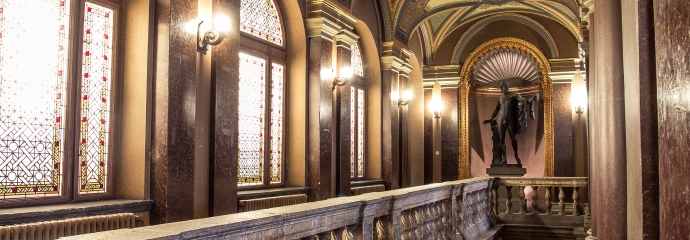The Hungarian University of Fine Arts

The Hungarian University of Fine Arts provides education and training to the future actors of the Hungarian cultural scene in all areas of the visual arts.
Our institution, during the course of its history, has preserved the traditional basis on which its educational program has been founded, while also seeking and cultivating continuous renewal, as evidenced by our new departments which began their operation in congruity with the fresh trends of contemporary arts in the past few decades.
In addition to practical training, theoretical subjects comprise a fundamental component of education at the HUFA.
Extending far beyond a general scope, a firm background in the specialized visual art-related branches of history, theory, sociology and psychology are of indispensable importance for our students. A high standard training for such a gifted group of students (chosen from an immense pool of applicants) demands more than a general grasp of art theory: it requires a strong theoretical grounding that is worthy of our students’ abilities and organically relates to the particularities of visual art.
The last 100 years in the history of fine arts has seen a rich array of fresh styles and trends. The emergence of a new style, whoever, has never resulted in a complete disappearance of the old: all approaches have remained “valid,” insofar as the talent of the artist allowed. While art cannot be rigid – outside influences must always be reacted to with sensitivity –, there have always been artists, who persisted in their use of a personally developed style, continuously shaping it, adjusting it, and increasing its complexity by incorporating new elements, but never quite surrendering the original concept.
It seems that a clearly dominant, popular contemporary style has not crystallized. The plurality of various forms exists on multiple levels; they can coexist with each other, side by side. Experimenters never quite fit in and it is natural for them to always encounter difficulties. Artists who wish to satisfy the demands of the general public must provide entertainment. Those nonconformists, however, whose art meets other functions, remain unique. In this way, old renegades and timid youngsters equally exist among artists.
Talented individuals are among the most highly prized treasures of a country; they determine the course of development and mark the direction in the arts. Society must seek to understand and support them. They must be given time for contemplation, for their personality to unfold and strengthen, so that they can prepare for a professional career, cultivate their heritage, and create new qualities. This is a challenging task not only for young talents, but also for the University, as, we are living in times when taking responsibility for ideas originating from one’s inner conviction is once again of import.
Prof. Frigyes Kőnig DLA, habil
Rector of the HUFA between 2005-2013
Management
| Rector | Prof. Dr. István Erőss |
| Vice-rector: | Szurcsik József |
| Vice-rector for Educational Affairs: | Orosz Csaba |
| Head of the Chancellor’s Cabinet, acting upon Chancellor’s legal power | Beáta Pápai |
| Head of the Rector's Cabinet: | |
| Head of the Department of Legal: | Dr Antal Polgár |
| Head of the Department of Finance: | Szilvia Martin |
| Head of the Department of Informatics | György Hajzer |
| Head of Department of Exhibitions: | Krisztina Vincze |
| Head of Department of International Relations: | Gabriella Nagy |
| Director of the Library, Archives, Fine Arts Collection: | |
| Head of the Registrar’s Department: | Beatrix Bíró |

